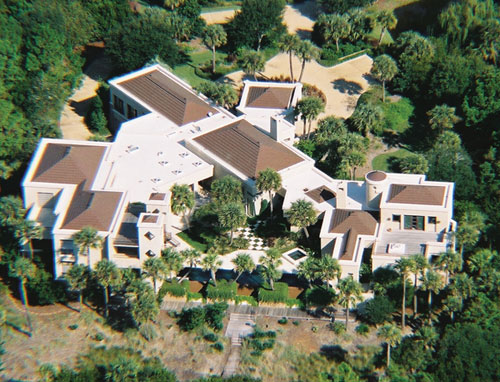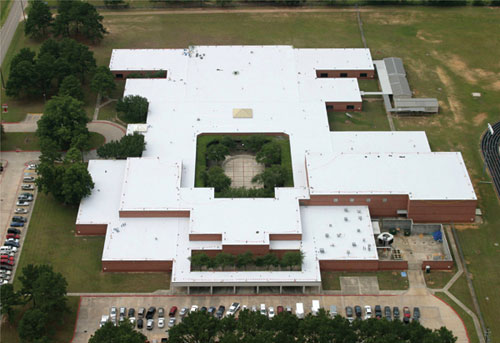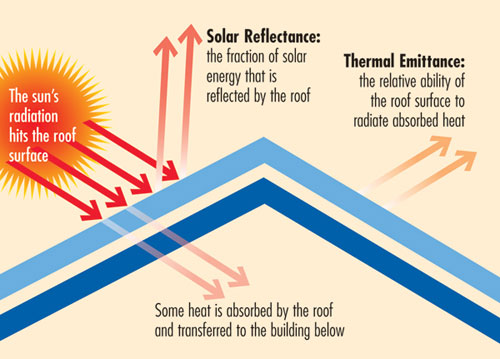Roofing Strategies Reach New Heights: Sustainable Options for a Key Building Element
Fluid-Applied Systems for Flat Roofs
On the opposite side of the roofing spectrum are fluid-applied roof systems. Rather than roof-applied tile-by-tile or shingle-by-shingle systems, fluid-applied roofing is a monolithic system used mostly in commercial settings. Primarily a flat or low-slope roofing solution, these systems are water-based elastomeric acrylic membranes reinforced with a non-woven polyester fabric. A base coat is applied and reinforced by the fabric and subsequent layers of coating. "It all cures as one monolithic system and forms its own flashings," says Quest Construction Products' Causey. Some manufacturers claim their fluid-applied systems waterproof all surface areas associated with the building's roof substrate including the interior and exterior parapet walls and caps, scuppers, drain bowls, through-roof protrusions and decks - and that when properly installed and maintained, fluid-applied systems can remain 100 percent waterproof regardless of weather conditions or age, with virtually no leak points. Roofing systems thus qualified can be covered by up to 20-year warranties on most roofing applications, which can be extended at the conclusion of the warranty period for additional 10-year periods under a prescribed maintenance schedule. In contrast, traditional roofing systems require leak-prone accessories such as sealants, tapes, adhesives, clamps, termination bars, drain rings or counter-flashings. In some cases, manufacturers of traditional roofing systems write exclusions into their warranties because they can't guarantee 100 percent waterproofing capabilities and cannot completely waterproof all areas above the roof substrate - a situation that architects should fully examine in selecting roofing options. "Other roofing manufacturers tend to warrant only their roofing product itself, as flashing is required and they do not manufacture those parts," says Causey, noting that with fluid-applied systems, the flashingis the product. The flashing is covered under the warranty, in all climates and conditions, provided the product is applied according to the manufacturer's specifications by an approved applicator and the proper inspections have been made before, during, and after the installation. Manufacturers may be able to supply years of successful applications as research data.
Manufacturers offer two types of fluid-applied roof systems:
- Reinforced 45 mil acrylic elastomeric systems generally consist of multiple layers of coatings that are reinforced with non-woven polyester fabrics. These systems may be installed directly to the existing roof, eliminating disposal and landfill costs. They are UV- and IR-resistant, have very low emission of volatile organic compounds and nontoxic formulations. System life may be extended with additional coatings every decade, and generally come with 10-year renewable warranties. If a new furnace or AC unit is installed, the designer should require the approved applicator and technical representative to inspect the job, applying new roofing materials to flash any new penetrations.
- Reinforced 50 mil acrylic elastomeric systems with fluoropolymer coatings are installed exactly like a typical 45 mil acrylic elastomeric system but have additional coatings that use state of the art fluoropolymer resins. A fluoropolymer is the next generation of resins - with great weathering and color retention properties. When paired with a fluid-applied roofing and waterproofing system, a flurorpolymer can extend the life of the sustainable roof, extending the time between recoats. The fluoropolymer coatings provide the same advantages of a typical fluid applied system and offer solar reflectivity ratings of 87 percent and higher, well above the SRI LEED compliance number for low slope roofs. "There are several colors that are rated by the Cool Roof Rating Council," says Causey. "White, however, is most often cited for its highly reflective properties. "Cool" colors also do exist, usually in the greys and tans. "The roof coatings also provide higher dirt pick-up resistance, improved color retention, reduced weathering rates - all with 20-year renewable warranties."
 |
A fluid-applied roofing system was used at a resort at Kiawah Island, South Carolina. Photo courtesy of Hydro-Stop/Quest Construction Products |
Â
A measurable amount of surface thickness is lost over the life of the product and can be replaced by additional coatings. Due to its chemistry, the regenerated fluid-applied roof is as strong as the original installation and will last for another set time period depending on the additional coating's mileage. "Unlike traditional roofing, fluid-applied roofs weather from the top down. So the top of the roof can be cleaned and refinished over and over again, without having to tear out the entire roof system," says Causey, noting that because 95 percent of roof substrates can be coated without requiring any tear off, fluid-applied roofs help to reduce landfill overload. To guarantee adherence, a clean, sound substrate is recommended. Most roof surfaces can be cleaned with water or water and a mild detergent. Since it is a waterborne product, specifications recommend applying the product in weather 40 °F and above.
Architects should make sure that a fluid applied roof system has an FM (Factory Mutual) 4470 approval as a stand alone roofing assembly. Currently there are two test methods being used for approval testing of mechanically attached roof systems, the FM 4470 and the Underwriters Laboratory (UL) 580 procedures. FM approval means that the product has been tested for a variety of parameters including interior and exterior fire exposure, wind uplift resistance, accelerated weathering, hail damage resistance, leakage resistance, foot traffic tolerance, and have passed third party formulations audits and third party production facility audits. In contrast, roof coatings - as opposed to roofing systems - are only tested for exterior fire exposure, and third party audits are not performed. Chad Roberson, AIA, LEED AP, of PBC+L Architecture in Asheville, NC, has used fluid-applied roofs in many applications, with considerable savings to clients. "They're easy to install, and you can patch the surface and it doesn't appear patched," he says, adding, "They're available in literally any color, almost like paint products."
A fluid-applied roof was used at the Tomball Independent School District in Tomball, Texas, to re-roof its Junior High and High School on a very limited budget. The district realized over $25,000 in savings with a reduction of 287,000 kWh one month after installation. The system subsequently stood up to Hurricane Ike with sustained winds of 90 mph and gusts up to 144 mph. Unlike many districts, Tomball did not have to pay for roof repairs as a result of the storm. "These roofing systems have made it through storms like Typhoon Paka with 241 mph wind gusts and Hurricane Wilma with 120 mph wind gusts," says Causey. "Because they're fully adhered and seamless, they can achieve high wind uplift ratings."Â
Classified as "cool" by the Cool Roof Rating Council, fluid-applied roofs can have solar reflectance as high as of .79, and a thermal emittance of .90. Fluid applied systems that utilize a Cool Roof Rating Council-approved top coating will further reduce the surface temperature as well as the internal temperature of a building. Any reduction of roof temperature will prolong the lifespan of not only the fluid applied system, but any pre-existing roofs and insulations as well. Cool roof rated fluid applied systems will also benefit roof mounted HVAC units as cooler air will be used in the heat exchange, which makes the units more efficient, and prolongs equipment life.
As opposed to asphalt-based products that must be heated during manufacturing and installation, fluid applied systems don't require heating. Most are waterborne, do not use heavy solvents as carriers, and are manufactured without any harmful by-products such as chlorine commonly out-gassed by various roof systems.
 |
A fluid-applied roof helped reduce energy costs at the Tomball Independent School District in Texas. Photo courtesy of Hydro-Stop/Quest Construction Products |
Â
Measuring Cool Roofs |
Cool roofs can reduce the roof surface temperature by up to 100 degrees Fahrenheit. Cooler roofs mean less heat is transferred into the building, less need for air-conditioning, lower energy and maintenance bills, enhanced occupant comfort and improved life cycle costs. "Coolness" is measured by solar reflectance and thermal emittance, with both properties expressed as a number from 0 to 1 and the higher the value, the "cooler" the roof. Solar reflectance, or albedo, is the measurement of the fraction of solar energy reflected by the roof. A value of 0.0 indicates that the surface absorbs all solar radiation, and a 1.0 value represents total reflectivity. Thermal emittance is a material's ability to release absorbed heat. Except for metals, construction materials typically have emittance above 0.80. A newer "coolness" evaluation method, incorporating both solar reflectance and thermal emittance, is the solar reflectance index (SRI). SRI measures a roof's overall ability to reject solar heat. Materials with the highest SRIs are the coolest choices for roofing. The numbers to remember are those stipulated by the U.S. Green Building Council which grants LEED points if 75 percent of the roof's surface is equal or greater than the following values - steep-sloped roofs require an SRI of at least 29, while low-sloped roofs (equal or less than 2:12) must have an SRI of over 78. |










